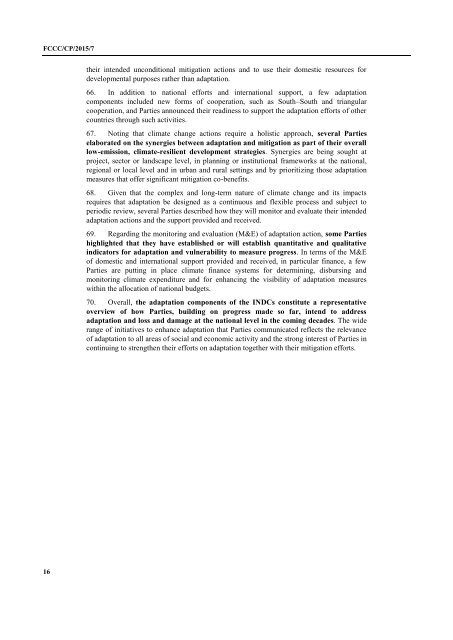FCCC/CP/2015/7
1PYuHQM
1PYuHQM
Create successful ePaper yourself
Turn your PDF publications into a flip-book with our unique Google optimized e-Paper software.
<strong>FCCC</strong>/<strong>CP</strong>/<strong>2015</strong>/7<br />
their intended unconditional mitigation actions and to use their domestic resources for<br />
developmental purposes rather than adaptation.<br />
66. In addition to national efforts and international support, a few adaptation<br />
components included new forms of cooperation, such as South–South and triangular<br />
cooperation, and Parties announced their readiness to support the adaptation efforts of other<br />
countries through such activities.<br />
67. Noting that climate change actions require a holistic approach, several Parties<br />
elaborated on the synergies between adaptation and mitigation as part of their overall<br />
low-emission, climate-resilient development strategies. Synergies are being sought at<br />
project, sector or landscape level, in planning or institutional frameworks at the national,<br />
regional or local level and in urban and rural settings and by prioritizing those adaptation<br />
measures that offer significant mitigation co-benefits.<br />
68. Given that the complex and long-term nature of climate change and its impacts<br />
requires that adaptation be designed as a continuous and flexible process and subject to<br />
periodic review, several Parties described how they will monitor and evaluate their intended<br />
adaptation actions and the support provided and received.<br />
69. Regarding the monitoring and evaluation (M&E) of adaptation action, some Parties<br />
highlighted that they have established or will establish quantitative and qualitative<br />
indicators for adaptation and vulnerability to measure progress. In terms of the M&E<br />
of domestic and international support provided and received, in particular finance, a few<br />
Parties are putting in place climate finance systems for determining, disbursing and<br />
monitoring climate expenditure and for enhancing the visibility of adaptation measures<br />
within the allocation of national budgets.<br />
70. Overall, the adaptation components of the INDCs constitute a representative<br />
overview of how Parties, building on progress made so far, intend to address<br />
adaptation and loss and damage at the national level in the coming decades. The wide<br />
range of initiatives to enhance adaptation that Parties communicated reflects the relevance<br />
of adaptation to all areas of social and economic activity and the strong interest of Parties in<br />
continuing to strengthen their efforts on adaptation together with their mitigation efforts.<br />
16


